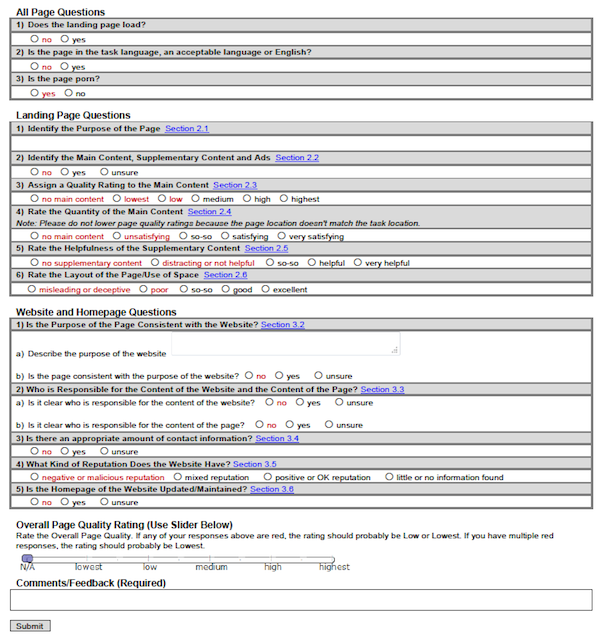A new version of Google’s human rater handbook has hit the web. The 161-page General Guidelines document, version 3.27 dated June 22, 2012, seems largely unchanged from last year, but has added a section instructing reviewers how to rate page quality.
As a reminder, Google’s Distinguished Engineer Matt Cutts insists that these ratings don’t “directly” affect the search engine results. However, the feedback from Google’s human raters no doubt play some part in the roughly 500 algorithmic tweaks that occur every year.
Regardless, this rating document provides a high-level view of what Google is looking for in a high-quality website. The handbook breaks down the aspects of a page into three main areas:
- Main Content: This could be in the form of a news article or a blog post, information about a product, a video, a tool, a search box, or a log-in.
- Supplementary Content: This could be internal navigation or links to related products or videos.
- Advertisements: These may also be referred to as ads, sponsored links, sponsored listings, or sponsored results.
As noted in the document, no pages, whether it’s news, forum, shopping, encyclopedia, or other, is automatically high or low quality. Also, ratings aren’t assigned based on a query. These reviews are strictly being done based on page quality.
High-Quality Pages
Essentially, Google’s view of high-quality content is anything that is “very satisfying, useful, or helpful for its purpose.” That purpose could be, according to the handbook, to:
- Share objective, personal, or social information
- Share an opinion
- Entertain
- Share pictures, videos, or other media
- Sell a product or service
- Post questions and answers
- Provide file-sharing or downloads.
High-quality pages have an obvious purpose. Experts have created a satisfying amount of factual/accurate content that is of near professional quality with editorial standards – even if the content creators are just regular folks. Good content takes time and effort to create and maintain. So content on high quality pages should be edited, reviewed, and updated.
Page layout is also part of the evaluation. The people behind high-quality pages ensure their content is the star of the page, rather than ads or other supplemental content (which, by the way, should be helpful and add to the user experience), and generally use the space well.
Another factor needed for the highest marks: a good reputation. Google has reviewers checking out to see whether websites are trusted, well-known, have won awards, or are authorities on a topic.
The handbook also give guidance on social networking pages for individuals, noting that signs of high quality social pages will have frequent updates, many social connections, and comments (meaning pages with few/no updates and little engagement will be marked as low quality).
Medium-Quality Pages
Medium-quality pages are essentially pages that are good and achieve their basic goal, but could easily be improved.
These types of pages would become high quality with more extensive content, a better design, or by improving their reputation/trust signals.
A number of negative reviews are one thing that could result in a medium rating.
Low-Quality Pages
Low-quality pages either lack purpose, fail to make their purpose clear, or exist to deceive or do harm. These pages may contain copied or scraped content or may be auto-generated, or generally just fail to provide users with the information they’re searching for.
Other signs of trouble:
- Factual errors.
- Grammatical errors.
- Paraphrasing/spinning content.
- Using a keyword repeatedly.
- Using too many words to share basic or obvious ideas or facts.
- Failure to cite sources.
Low-quality pages also have bad design, or perhaps have technical errors that prevent some content from loading. Others may be deceptive, having only been created to make money via ads or affiliate links rather than to provide helpful information.
Other signs of low-quality pages: a lack of credibility or trustworthiness (e.g., no contact information), or are harmful to users (e.g., phishing or malicious download pages). Also, these sites likely have an overwhelmingly negative reputation.
Pages will also receive the lowest rating if it violates any of Google’s Webmaster Guidelines, all of which are covered elsewhere and throughout the document.
Here’s a look at the page quality rating task page Google’s human reviewers must fill out:

We’re still digging into the document to see if there are any other noteworthy changes since the March 30, 2011 version.
Want to get your hands on your own copy of the full document before Google gets it taken down? Do a Google search for “General Guidelines version 3.27”.
Hat tip to Razvan Gavrilas at CognitiveSEO, who was first to report on the leaked document earlier today.
